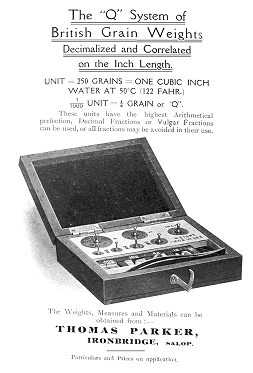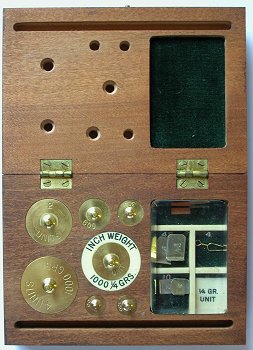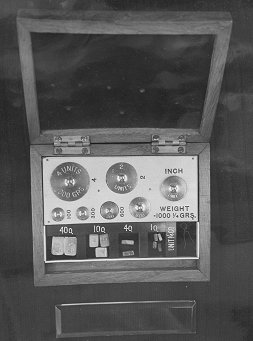|
His metric system of weights and measures was
based on the inch. He cast a one inch aluminium cube that
weighed exactly the same as one cubic inch of water at 4 degrees
centigrade. After casting, it was accurately filed by one of his
sons and became the primary unit of linear, square and cubic
measurement, and also of weight. He carried it with him
everywhere and played it as a trump card in many arguments
concerning British weights and measures.
Read
Norman Biggs
article on Thomas
Parker's Inch Weights |

|
 |
An advert for Thomas's
"British Grain Weights".
Courtesy of the library and archives
of the Ironbridge Gorge Museum, at Coalbrookdale. |
| A box of Thomas's inch
weights.
Courtesy of the library and archives
of the Ironbridge Gorge Museum, at Coalbrookdale. |
 |
 |
Another box of inch
weights.
Courtesy of the library and archives
of the Ironbridge Gorge Museum, at Coalbrookdale. |
| Some of Thomas's booklets
advertising his coins and weights.
Courtesy of the library and archives
of the Ironbridge Gorge Museum, at Coalbrookdale. |
 |
At the top of the above photograph is a leather
wallet, containing a booklet and sample coins. Thomas gave one to
every Member of Parliament in the hope of gaining support for his
decimal system. Thomas's grandson, Clive Parker, also attempted to
interest people in Thomas's system in the late 1950s and early
1960s. At this time only one of the wallets still survived. It was
lent to G.W. Proudfoot, M.P. and he put it on display in the House
of Commons library.

|
|

|
|

|
Return to the
Metropolitan Rlwy |
|
Return to the beginning |
|
Proceed to
Coalbrookdale |
|